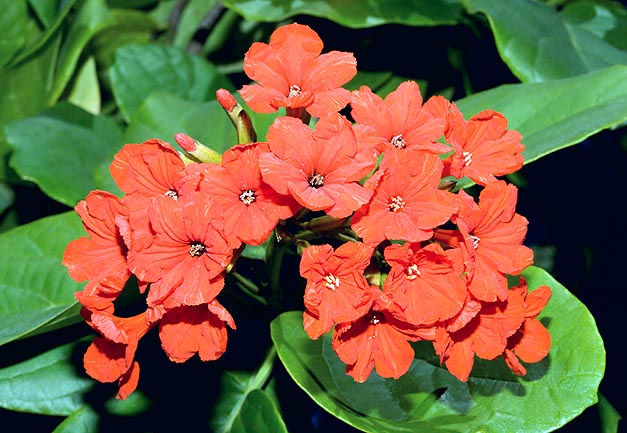Family : Boraginaceae

Text © Pietro Puccio

English translation by Mario Beltramini

A tropical small tree akin to the Myosotis, with showy inflorescences and medicinal properties © G. Mazza
The genus is honoured to the German physicians and botanists Euricius Cordus (1486-1535) and his son Valerius (1515-1544); the name of the species comes from the resemblance of its fruit to the Cordia mixa ’s one, called in Farsi “sebestan”.
Common names: “geiger tree”, large-leaf geiger tree”, “scarlet cordia” (English); “bois râpe”, “sébestier” (French); “sebesteira-verdadeira” (Portuguese); “anacahuita”, “anacuáhuitl”, “anaconda”, “macahuite”, “canalete”, “no me olvides”, “palo de asta”, “siricote blanco”, “sanjoaquín”, “siricote de playa”, “trompillo”, “uvita mocosa”, “ziricote” (Spanish); “Scharlachkordie”, “Sebestenenbaum” (German).
Small evergreen tree with a thick foliage, tall up to 9 m and diameter of the trunk up to 30 cm, has simple leaves, oval or elliptical, 10-20 cm long and 5-12 cm broad, with entire margin or irregularly indented towards the apex, of an intense green colour and rugose to the touch on the upper side, due to the presence of short rigid hair.
The inflorescences are terminal, panicle, carrying several hermaphrodite flowers, funnel-shaped, with a corolla of 3-4 cm of diameter with 5-6 irregular lobes, creped, of a bright orange-red colour.
The fruits are white ovoid drupes, 2-4 cm long, containing from 1 to 4 seeds. It reproduces by seed, blossoming from the third year of age, by cutting and by
air layering.
Very ornamental plant with cultivation limited to the tropical and subtropical zones, as it stands only for a very short time, and with loss of the foliage, temperatures around or just below 0 °C.
The best exposition is in full sun, but it adapts also to partially shaded situations, as well as to an ample variety of soils, both acidic and alkaline and also slightly saline, even if preferring sandy and well draining soils.
It takes advantage of regular watering, but can stand also long drought periods. Thanks to its almost uninterrupted blossoming, which catches the eye between the intense green of the foliage, it is often utilized both in private and public gardens, and as road tree, in particular close to the sea-side, as it resists well to saline aerosols.
The fruits are edible, but not of a particularly pleasant taste and have a very limited consumption; all the parts of the plant are variously utilized in the traditional medicine.
The wood obtained from the trunk is appreciated for its toughness, the high density, the thin grain and for the pattern of the dark venations, which is utilized for sculptures, music instruments and small objects.
Synonyms: Cordia speciosa Salisb. (1796); Cordia laevis Jacq. (1797); Sebestena sebestena (L.) Britton (1913).
→ To appreciate the biodiversity within the BORAGINACEAE family please click here.
